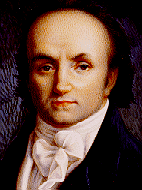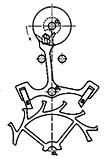by: C.D. Unninayar
 During the religious wars in France, the Protestant Breguet family left
its native Picardie in 1685 to find refuge in the western part of Switzerland. The Breguet
name was thus destined to become famous in both countries, each claiming its famous son,
Abraham-Louis Breguet. The future watchmaker was born in Neuchâtel, a village of 3500
inhabitants, on January 10, 1747. His father, Jonas-Louis Breguet, was a merchant who
belonged to the local bourgeoisie. In 1752, he became proprietor of an inn in Les
Verrières, a small village near Neuchâtel, which was a stopover point for travelers on
their way to Burgundy and Paris.
During the religious wars in France, the Protestant Breguet family left
its native Picardie in 1685 to find refuge in the western part of Switzerland. The Breguet
name was thus destined to become famous in both countries, each claiming its famous son,
Abraham-Louis Breguet. The future watchmaker was born in Neuchâtel, a village of 3500
inhabitants, on January 10, 1747. His father, Jonas-Louis Breguet, was a merchant who
belonged to the local bourgeoisie. In 1752, he became proprietor of an inn in Les
Verrières, a small village near Neuchâtel, which was a stopover point for travelers on
their way to Burgundy and Paris.
Abraham-Louis spent a rather normal childhood although in school he was considered a
bit of a dreamer who did not really apply himself.
In 1758, tragedy struck. Jonas-Louis died, leaving his wife, Suzanne-Marguerite, alone
with their two young daughters and the 11-year old Abraham-Louis. Sometime later,
Suzanne-Marguerite married her late husband's cousin, Joseph Tattet, a watchmaker who had
business contacts with France.
Learning his craft
In 1762, Tattet found his 15-year old stepson an apprenticeship with a watchmaker
friend in Versailles. Three years later, the young Breguet was in Paris, and would study
with famous artistic watchmakers such as Ferdinand Berthoud (1727-1807),
watchmaker-mechanic to the King and Navy, and Jean-Antoine Lépine (1720-1814), watchmaker
to the King. Breguet also took classes in physics, optics, astronomy, mechanics and
mathematics at the College Mazarin where he met the Abbot Joseph-François Marie
(1738-1801). This generous man would later take the young apprentice under his wing and
provide protection and support for him and his younger sisters. During these early years,
Breguet learned his craft well.
The love of his life
Love came into the young watchmaker's life with Cécile L'huillier, the daughter of a
wealthy family. The young couple married in 1775. As a wedding present, Cécile's father
helped Breguet and his bride settle into an apartment at 39 Quai de l'Horloge on the Ile
de la Cité in Paris. This neighborhood was already the home of many of the most
prestigious watchmakers in Paris. At 28 years of age, Breguet now launched his own
business, and was about to launch his own family. A son, Antoine-Louis, was born the next
year. Business was prospering and his life's dreams seemed fulfilled.
But tragedy struck again. In 1780, during the fifth year of their marriage, Cécile
died. Grief-stricken, Breguet plunged himself into his work and his inventions. He never
remarried.
The watchmaker of reference
On a commercial level, Breguet was becoming well known and highly regarded. His
brother-in-law and the Abbot Marie introduced him to the aristocracy. His first major
customer, the Duke of Orleans, bought one of his "perpétuelle" watches in 1780.
Two years later, the House of Breguet gained an even greater client, Marie-Antoinette.
With the queen's support, his reputation grew not only in France but all over the
Continent. In 1784 he earned the title of Master Watchmaker. Soon Breguet became the
watchmaker of reference for the scientific, diplomatic, military and financial elite
Europe. His understanding of technical mechanics as well as human character and talent
allowed him to attract the best craftsmen and train them in order to realize the many
products which emerged from his abundantly fertile imagination. In addition, Breguet
possessed that unique combination of intuition and intelligence so necessary to provide
for the skillful marketing of his products. He built up an international sales network
through his personal contacts and his prestigious client base that, over the years, would
be constantly renewed by the changing political picture.
From perpétuelles to politics
Concerned with social reform, Breguet was sympathetic to the political ideas that were
gaining ground at the time in France. He joined the Jacobins, a revolutionary group under
the leadership of the radical Jean-Paul Marat, whose sister made watch hands for Breguet.
The threads of the lives of these two men were to become closely intertwined on at least
two other occasions. In the 1780s, Paris was a boiling cauldron of political unrest. By
the early 1790s, the situation was so dangerous that Breguet sent his son, Antoine-Louis
to England for safety. Early in 1793, the Jacobins split into two groups, the moderate
Girondins and the radical Montagnards. They began fighting not only the royalists, but
also each other. The rabble-rousing radical Marat allied with the Montagnards.
Marat and the Reign of Terror
Despite their political differences, Breguet and Marat remained friends. In April 1793,
while the two men were visiting a mutual acquaintance in Paris, a royalist crowd gathered
outside demanding Marat's head. He was trapped. To save his friend, Breguet dressed him up
as a woman, complete with powdered face and reddened cheeks. They waited until evening and
then calmly walked out arm in arm, mingling with the crowd until Marat could flee to
safety. The revolutionary had the opportunity to return the favor two months later.
Hearing that Breguet, because of his royalist connections, had been placed on a death list
by the Revolutionary Committee, Marat urged him to leave France. He arranged for
safe-conduct passes for Breguet and his son, who had returned from England, to get across
the Swiss border. It was the last time that the watchmaker would see his friend. On July
13, the eve of the Fête Nationale, Jean-Paul Marat was stabbed to death in his bathtub by
a young member of the Girondins, Charlotte Corday.
A month later under the blazing August sun, Breguet and his son fled Paris for
Switzerland. Because of his escape, Breguet was condemned as a traitor. The Committee of
Public Safety confiscated his factory and shot one of his workers. His home and workshops
were ransacked. His tools and equipment were destroyed. France's Reign of Terror had
begun.
Sanctuary in Switzerland
In the relative calm of Switzerland, Breguet first went to Geneva and then in November
returned to the village of his birth. By the end of the year, the inventor had settled in
Le Locle, a village near Neuchâtel, where he set up a small workshop. Breguet used his
two-year exile to perfect many of his ideas and innovative techniques in watchmaking.
The House of Breguet
The Terror passed. Calm returned to France. In May 1795, Breguet returned to Paris,
reclaimed his house and obtained the restoration of his workshops from the new government.
But the city was emotionally and economically exhausted. The Reign of Terror had decimated
the aristocracy, the main clients of the House of Breguet. In their stead, though, new
social classes were forming. This rich bourgeoisie, along with the new Napoleonic
aristocracy became Breguet's new clients. The economic difficulties which still plagued
the watch industry caused Breguet to create a unique system of "souscription". A
buyer could pay 25% down for a watch of a limited series, with the balance due upon
delivery. In this manner, Breguet watches became more accessible and the payments in
advance helped finance the development of other projects.
The latter part of Abraham-Louis' life was amply marked by recognition. Clients of the
House of Breguet included the Empress Josephine (1806), the King of England (1810) and
many other crowned heads of Europe. Breguet was appointed to the Board of Longitude in
1814 and a year later was named as Watchmaker to the Royal Navy. In 1819, he was nominated
to the prestigious Academy of Sciences by decree of King Louis XVIII. That same year, he
was awarded the Legion of Honor. At the 1819 Paris Exhibition, the master watchmaker
proudly presented a resume of his life's scientific achievements.
Time claims the keeper
The aging Breguet remained professionally active and enjoyed good health, except for a
hearing loss. Tuesday September 17, 1823 found the inventor at his workshop as usual. As
the morning sun filtered in through the half-shuttered window, the hands on his beloved
pocket watch stopped. It was 8:37. Time claimed its keeper.
According to his wishes, Abraham-Louis Breguet's body was laid to rest in Père
Lachaise in Paris. His spirit and legend live on.

 PRECISION WATCH REPAIR BY CHARLIE SQUIRES
PRECISION WATCH REPAIR BY CHARLIE SQUIRES